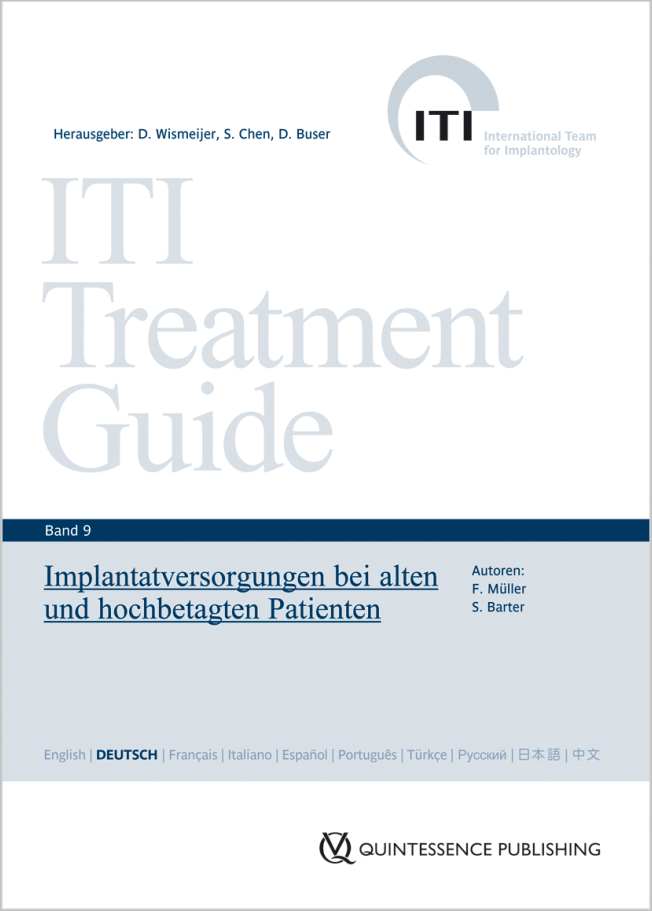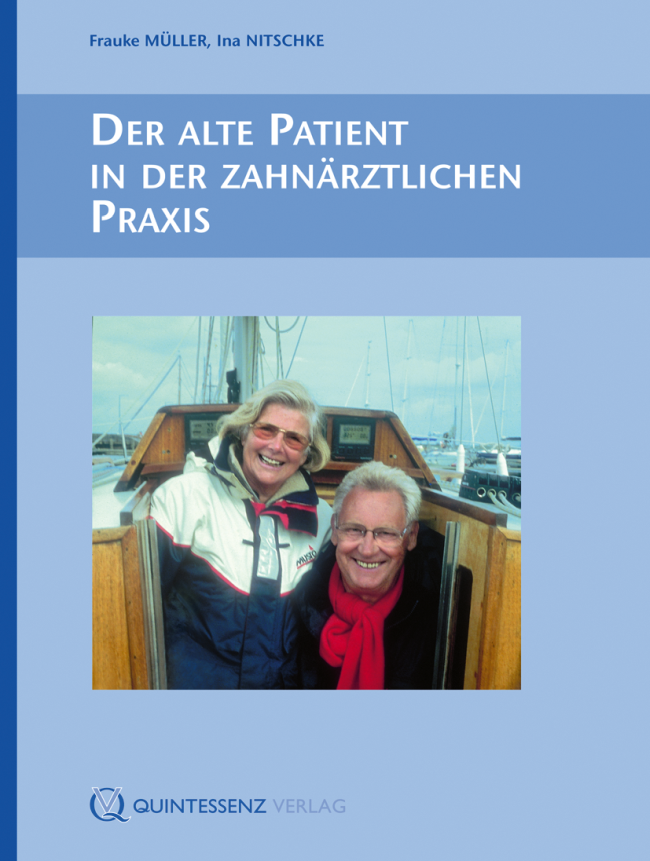The International Journal of Prosthodontics, Pre-Print
DOI: 10.11607/ijp.9236, PubMed ID (PMID): 3999316624. Feb 2025,Pages 1-31, Language: EnglishUtz, Karl-Heinz / Lückerath, Walter / Schwarting, Peter / Noethlichs, Wolfgang / Büttner, Ralph / Grüner, Manfred / Fuß, Edgar / Stark, Helmut / Müller, FraukePurpose: This study comprises the fifth and final part of a comprehensive investigation of the positions of the temporomandibular joint condyles. In this evaluation, we wanted to investigate the neuromuscular position of the mandible. Materials and Methods: The neuromuscular condylar positions were recorded by four independent operators in 81 fully dentate subjects with healthy oral function using a central bearing point system and rapid closing movements. The "most frequent adduction point" was determined, and the recordings were repeated twice for each subject. The subjects' maxillary casts were mounted in an articulator using an individual facebow transfer, subsequently the mandibular. casts were mounted with a central-bearing-point registration on the tip of the Gothic arch, i.e. in centric condylar position. A custom-made electronic measuring articulator was used to determine the spatial distance between the condyles in centric relation, maximal occlusion and the newly determined neuromuscular position. Results: The reproducibility of the neuromuscular registrations was on average 0.52±0.16 mm (range 0.04-2.53 mm) with the right and left side averaged. The spatial distances of the condyles between maximal intercuspal position and neuromuscular positions were 0.88±0.30 mm (range 0.12-5.98 mm), again averaged for the right and left sides, whereas the ones between the centric condylar position and the neuromuscular positions were 0.83±0.27 mm (range 0.10-7.89 mm). Conclusions: The neuromuscular mandibular position is neither identical to maximal intercuspal position nor to centric relation. It can therefore be concluded, that the registration of the neuromuscular adduction field should not be recommended for prosthodontic restorations in dentate or edentulous patients.
Deutsche Zahnärztliche Zeitschrift, 1/2024
OriginalarbeitPages 40-50, Language: GermanSchiller, Simone / Rustemeier, Elke / Kraus, Dominik / Stark, Helmut / Müller, Frauke / Utz, Karl-HeinzEinführung: Der Großteil der Totalprothesen wird derzeit noch immer konventionell im Wachs-Kunststoff-Transformationsverfahren hergestellt. Abhängig vom Polymerisationsprozess kann dabei eine Formänderung des Prothesenkörpers zu einer Passungenauigkeit im Vergleich zur ursprünglichen Abformung führen. Dies betrifft insbesondere den Bereich des dorsalen Randes von Oberliefer-Totalprothesen. Ziel dieser Studie war es, die Größe des Spalts von Oberkiefer-Totalprothesen am posterioren Abschluss nach der Polymerisation mit verschiedenen Kaltpolymerisaten in dreidimensionaler Ausdehnung und unter dem Einfluss verschiedener Gaumenformen zu ermitteln.
Material und Methode: Untersucht wurden vier kaltpolymerisierende Kunststoffe. Auf 120 Gipsmodellen mit drei unterschiedlichen Gaumenformen (hoch, mittel, flach) wurden für jede der vier Gruppen jeweils zehn Prothesen für den flachen, mittleren und hohen Gaumen im Gießverfahren angefertigt. Die dreidimensionale Erfassung des Spalts erfolgte mittels Abformung mit einem dünnfließenden Silikon und anschließender Vermessung mithilfe eines Scanners.
Ergebnisse: Die Form des Gaumens hatte einen signifikanten Einfluss auf die Passungen der Prothesen am dorsalen Abschluss (Median p = 0,0435), nicht jedoch die verschiedenen Arten der Kaltpolymerisate (Median p = 0,2575). Die Spaltbreite war für die flache Gaumenform am größten und am kleinsten für den hohen Gaumen. Die größten Spalten wurde im Bereich der Raphe palatina mediana (flacher Gaumen 685 μm, hoher/mittlerer Gaumen 620 μm) beobachtet; die Größe nahm nach lateral zu den Tubera und nach anterior hin ab.
Schlussfolgerung: Zur Kompensation der dorsalen, auf die Polymerisationsschrumpfung zurückzuführenden Passungenauigkeit an der Aha-Linie ist eine kastenförmige, ca. 5 mm breite und im Bereich der Raphe palatina mediana ca. 0,7 mm tiefe Radierung des Meistermodells anzuraten, die nach lateral und anterior abnimmt. Hohe und mittelhohe Gaumenformen erfordern eine weniger ausgeprägte Radierung.
Keywords: dorsale Randabdämmung, dorsaler Randspalt, Oberkiefer-Totalprothese, PMMA, Radierung Meistermodell
The International Journal of Prosthodontics, 6/2022
DOI: 10.11607/ijp.7158Pages 730-737, Language: EnglishBouattour, Yasmine / Kalberer, Nicole / Chebib, Najla / Mojon, Philippe / Mehl, Albert / Srinivasan, Murali / Müller, FraukePurpose: To evaluate the effects of overnight storage conditions on the dimensional stability and retention of prostheses, as well as participants’ subjective perceptions of these interventions.
Materials and Methods: Subjects with maxillary complete prostheses (CRPs) were randomly assigned to receive two interventions in a crossover design: storage of their CRPs overnight in a dry environment or in a wet environment with a cleansing tablet. The denture intaglio surface was scanned, and outcome measures were collected before each intervention (BLN), postintervention (PIS), and after immersion in water for 15 minutes (WOC) following each intervention. Dimensional changes were analyzed for the total surface, anterior flange, palate, and tuberosities. Retention force was measured using a dynamometer, and the participants’ subjective assessments of comfort, fit, and retention of their CRPs were collected. After verifying normal distribution, paired t and Wilcoxon signed rank tests were used to check for statistical significance (α = .05).
Results: Ten participants (mean age: 76.5 ± 5.9 years) were recruited. Between BLN and PIS, the dimensional changes after dry intervention were significantly less than the wet intervention for the total surface (P = .009), anterior flange (P = .028), and palate (P = .005). No difference was found between the effects of storage or washout interventions on objectively measured CRP retention. However, after WOC following dry storage, participants perceived a lower retention (P = .021), and after WOC following wet storage, participants perceived a more comfortable palate (P = .018).
Conclusion: For dimensional stability, dry overnight storage of removable prostheses can be safely recommended when indicated. Immersion in water for 15 minutes does not seem to add advantages.
QZ - Quintessenz Zahntechnik, 12/2021
ErfahrungsberichtPages 1384-1400, Language: GermanSrinivasan, Murali / Kalberer, Nicole / Maniewicz, Sabrina / Müller, FraukeZwei unterschiedliche PatientenbeispieleImplantatparallelität gilt insbesondere bei Verwendung freistehender Verankerungssysteme (unverblockte Halteelemente) als ein entscheidendes Kriterium für die erfolgreiche Rehabilitation zahnlose Kiefer mit implantatverankerten Deckprothesen. In dem Beitrag wird der Einsatz eines neuartigen Deckprothesen-Halteelements mit der Fähigkeit zu einer echten Achsenkorrektur in komplexen Fällen mit großen Implantatachsendivergenzen gezeigt. Das CM-LOC-FLEX-Halteelement (Fa. Cendres+Métaux, Biel, Schweiz) ermöglicht eine solche Korrektur. Zudem wird die Verwendung von Polyetherketonketon (PEKK) als Gerüstmaterial für die Herstellung komplett metallfreier Deckprothesen demonstriert.
Keywords: Implantatprothetik, Halteelement, Implantatachse, PEKK, Gerüst
Implantologie, 1/2021
Pages 7-23, Language: GermanSchimmel, Martin / Müller, Frauke / Suter, Valerie G. A. / Buser, Daniel / Abou-Ayash, Samir / Srinivasan, MuraliDie Implantattherapie bei älteren Menschen bedarf einer gezielten Planung. Dabei spielt die Unterscheidung zwischen dem dritten und vierten Lebensabschnitt für die Behandlungsplanung und die anschließende zahnärztliche Betreuung eine wichtige Rolle, da diese Patientengruppen sich fundamental voneinander unterscheiden. Für Menschen des dritten Lebensabschnitts steht das gesamte Spektrum der zahnärztlichen Implantologie zur Verfügung, allerdings müssen chronische Erkrankungen, Medikation und manuelle Geschicklichkeit beachtet werden. Da dentale Implantate meist deutlich länger als 20 Jahre im Mund verbleiben, muss prospektiv die zukünftige Abnahme der biologischen, sozialen und kognitiven Funktionen bei der Planung berücksichtigt werden. Im vierten Lebensabschnitt ist das Leben von der Abhängigkeit bei den Aktivitäten des täglichen Lebens (ADL), Multimorbidität, Polypharmazie und Institutionalisierung bestimmt. Es gibt fast keine wissenschaftliche Evidenz zur Implantattherapie dieser Patientengruppe. Die wenigen vorhandenen Studien zeigen eine sehr hohe Implantatüberlebensrate und es gibt Hinweise auf verringerte akute periimplantäre Entzündungsreaktionen. Gerade Patienten in der vierten Lebensphase könnten am meisten vom funktionellen Gewinn einer implantatstabiliserten Totalprothese profitieren, wenn die muskulären Fähigkeiten zur Stabilisierung einer Prothese nachlassen. Allerdings müssen Handhabung, Nachsorge und tägliche Pflege gesichert werden, bevor mit einer solchen Therapie im Sinne des Nichtschadensgebots begonnen wird. Menschen im palliativen Kontext weisen zunehmend Implantate auf, die die Betroffenen und die Pflegenden vor große Herausforderungen stellen können. Hier müssen die Implantatprothesen rechtzeitig „rückgebaut“ werden, um Schmerzen und Infektionen zu vermeiden.
Manuskripteingang: 06.01.2021, Annahme: 19.02.2021
Keywords: Implantologie, Gerodontologie, dritter Lebensabschnitt, vierter Lebensabschnitt, chirurgische Strategien, prothetische Strategien
Quintessenz Zahnmedizin, 4/2020
AlterszahnmedizinPages 440-450, Language: GermanWeber, Adrian / Müller, Frauke / Zimmermann, Patrick / Schimmel, MartinEin FallberichtDer demographische Wandel bedingt, dass immer häufiger zahnärztliche und prothetische Versorgungskonzepte für hochbetagte Patienten angeboten werden müssen. Dies impliziert oft nicht nur allgemeinmedizinische, sondern vor allem auch konzeptionelle Herausforderungen. So können eine eingeschränkte manuelle Motorik und Adaptationsfähigkeit zur Verweigerung einer prothetischen Neuversorgung führen, was sowohl für den Patienten als auch für den behandelnden Zahnarzt einem Scheitern gleichkommt. Duplikationsverfahren stellen seit jeher eine sinnvolle Alternative zur Anfertigung von Zahnersatz für betagte Patienten mit reduzierter Neuroplastizität dar. Charakteristisch für dieses bewährte Konzept ist nicht die vollständige Kopie einer prothetischen Versorgung, sondern die selektive Übernahme von suffizienten Anteilen bei gleichzeitiger Verbesserung insuffizienter Eigenschaften des zu erneuernden Zahnersatzes. Mit Hilfe von 3-D-Scans können Abformungen, Bissnahmen und Zahnaufstellungen bei der digitalen Kopie der alten Prothese Anwendung finden. Diese Verfahrenswege sind präzise und kostengünstig. Veränderungen lassen sich klinisch auf ihre Akzeptanz testen, ohne dass bereits die kompletten Kosten eines neuen Zahnersatzes fällig werden. Die digitale Speicherung der Prothese ist weiterhin eine wertvolle Referenz für den Fall, dass sie verloren geht. Der Beitrag beschreibt eine neue digitale Duplikationsmethode zur Herstellung von Totalprothesen.
Keywords: Duplikatprothese, ausgeprägte Kieferatrophie, Gerodontologie, Adaptationsfähigkeit, CAD/CAM-gefertigte Totalprothesen
Journal of Craniomandibular Function, 3/2020
Pages 227-245, Language: German, EnglishLindfors, Erik / Arima, Taro / Baad-Hansen, Lene / Bakke, Merete / De Laat, Antoon / Giannakopoulos, Nikolaos Nikitas / Glaros, Alan / Guimarães, Antonio Sergio / Johansson, Anders / Le Bell, Yrsa / Lobbezoo, Frank / Michelotti, Ambra / Müller, Frauke / Ohrbach, Richard / Wänman, Anders / Magnusson, Tomas / Ernberg, MalinAn International Modified Delphi StudyAim: To investigate whether an international consensus exists among TMD experts regarding indications, performance, follow-up, and effectiveness of jaw exercises.
Materials and Methods: A questionnaire with 31 statements regarding jaw exercises was constructed. 14 international experts with some geographic dispersion were asked to participate in this Delphi study, and all accepted. The experts were asked to respond to the statements according to a 5-item verbal Likert scale that ranged from "strongly agree" to "strongly disagree." The experts could also leave free-text comments, which was encouraged. After the first round, the experts received a compilation of the other experts' earlier responses. Some statements were then rephrased and divided to clarify the essence of the statement. Subsequently, the experts were then asked to answer the questionnaire (32 statements) again for the second round. Consensus was set to 80% agreement or disagreement.
Results: There is consensus among TMD experts that jaw exercises are effective and can be recommended to patients with myalgia in the jaw muscles, restricted mouth opening capacity due to hyperactivity in the jaw closing muscles, and disc displacement without reduction. The patients should always be instructed in an individualized jaw exercise program and also receive both verbal advice and written information about the treatment modality.
Conclusion: This Delphi study showed that there is an international consensus among TMD experts that jaw exercises are an effective treatment and can be recommended to patients with TMD pain and disturbed jaw function.
(Original article published in J Oral Facial Pain Headache 2019; 33:389–398. doi: 10.11607/ofph.2359)
Keywords: Delphi technique, dentistry, jaw exercises, orofacial pain, physical treatment
The International Journal of Prosthodontics, 6/2019
DOI: 10.11607/ijp.6469, PubMed ID (PMID): 31664264Pages 482-496, Language: EnglishSrinivasan, Murali / Kalberer, Nicole / Maniewicz, Sabrina / Müller, FraukeImplant parallelism is considered a cardinal criterion for the successful rehabilitation of edentulous jaws with implant-retained overdentures (IODs), especially if freestanding anchorage systems (unsplinted attachments) are employed. This report aimed to demonstrate the successful use of a novel IOD attachment with a true-alignment capability in complex cases with large inter-implant angular discrepancies. The report further aimed to highlight the use of a novel polyetherketoneketone (PEKK) framework as a reinforcement material for fabricating a completely metal-free IOD. Although some freestanding attachments exploit their geometric form and/or use various retentive inserts to compensate for inter-implant angular discrepancies, a true-alignment correction is seldom achieved. The CM LOC FLEX (Cendres+Métaux attachment provides a true alignment correction and produces parallelism between implants in clinical situations where the implants are not parallel to one another. The functionality of the CM LOC FLEX was described in this case report for two different clinical situations: a conventional mandibular IOD retained by two implants, and a maxillary IOD retained by four implants. Both cases involved a complex clinical situation with compromised implant parallelism. The CM LOC FLEX abutment has a true-alignment correction mechanism that can be advantageous in clinical situations where the inter-implant axial alignments are not parallel. PEKK frameworks are lightweight, strong, and can be esthetic substitutes for conventional metal frameworks. However, welldesigned clinical studies are further needed to assess the clinical performance as well as the maintenance requirements of the illustrated novel attachment and the PEKK framework before advocating them as validated and standard protocols.
Journal of Oral & Facial Pain and Headache, 4/2019
Pages 389-398, Language: EnglishLindfors, Erik / Arima, Taro / Baad-Hansen, Lene / Bakke, Merete / De Laat, Antoon / Giannakopoulos, Nikolaos Nikitas / Glaros, Alan / Guimarães, Antonio Sergio / Johansson, Anders / Le Bell, Yrsa / Lobbezoo, Frank / Michelotti, Ambra / Müller, Frauke / Ohrbach, Richard / Wänman, Anders / Magnusson, Tomas / Ernberg, MalinAims: To investigate whether an international consensus exists among TMD experts regarding indications, performance, follow-up, and effectiveness of jaw exercises.
Methods: A questionnaire with 31 statements regarding jaw exercises was constructed. Fourteen international experts with some geographic dispersion were asked to participate in this Delphi study, and all accepted. The experts were asked to respond to the statements according to a 5-item verbal Likert scale that ranged from "strongly agree" to "strongly disagree." The experts could also leave free-text comments, which was encouraged. After the first round, the experts received a compilation of the other experts' earlier responses. Some statements were then rephrased and divided to clarify the essence of the statement. Subsequently, the experts were then asked to answer the questionnaire (32 statements) again for the second round. Consensus was set to 80% agreement or disagreement.
Results: There is consensus among TMD experts that jaw exercises are effective and can be recommended to patients with myalgia in the jaw muscles, restricted mouth opening capacity due to hyperactivity in the jaw closing muscles, and disc displacement without reduction. The patients should always be instructed in an individualized jaw exercise program and also receive both verbal advice and written information about the treatment modality.
Conclusion: This Delphi study showed that there is an international consensus among TMD experts that jaw exercises are an effective treatment and can be recommended to patients with TMD pain and disturbed jaw function.
Keywords: Delphi technique, dentistry, jaw exercises, orofacial pain, physical treatment
2018-2
Pages 102-115, Language: EnglishBarter, Stephen / Müller, FraukeThe global burden of ageing also presents a challenge for dentistry. our patients are becoming older and losing their natural teeth later in life. It is widely acknowledged that advanced age alone is not a contraindication for implants; it is the chronic conditions of the older patient, the treatments and side effects, as well as concomitant functional impairment that may limit the survival and success rates of dental implants. For many chronic conditions, the evidence in relation to implant survival is lacking or inconsistent, for example in osteoporosis and diabetes. other conditions show similar implant survival rates to younger adults. In patients having undergone radiotherapy, implant survival rates appear lower. The only absolute contraindication for implant placement is anti-resorptive therapy in the treatment of bone metastases. In addition to risks related to chronic conditions, functional impairment, oral hygiene, immunosenescence, and patient compliance should be considered. For example, complex sophisticated reconstructions should be simplified in good time and overdenture retention adjusted to aid autonomous denture management. The decision whether or not to provide dental implant treatment to the ageing patient, even with multiple morbidities and a complex pharmcotherapeutic regime, cannot be based on the predicted outcome in terms of implant survival or success alone. It requires due consideration of the patient's life expectancy and the potential increase in quality of life, weighed against the morbidity of the procedure itself as well as potential adverse effects on the activities of daily life.
Keywords: medical conditions, medications, ageing, dental implant, polypharmacy, multimorbidity





